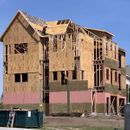Multiple WRBs (Tyvek over a fluid-applied air barrier)
I’m wondering about the my Weather Resistive Barrier (WRB) game plan for my house under construction. I started my plan by putting a Joint and Seam filler made by Prosocco in the joints of my Advantec sheathing. After completing all the seams I painted the first row of the Advantec sheathing (we used pressure treated plywood on the first 4ft) with the R-Guard Spray Wrap MVP (Prosocco Fluid Applied Barrier) See photos. I am going to spray the rest of the house with this Spray Wrap MVP ($160 per 5 gal and requires 40 more gallons plus $2,500 for the contractor to apply). I was also going to Tyvek the entire house afterwards (the Tyvek was already included in the build cost). Is this overkill? I wanted a secondary layer of moisture protection in case we had a failure of the Tyvek due to installation error or if it were damaged in major storm or hurricane. We had many houses in my area damaged during Hurricane Florence last summer. House sidings were ripped off from the wind and the Tyvek tore exposing the sheathing to wind driven rain causing water infiltration into many houses. We live in a beach community (Hurricane prone area) where wood rot is a major problem already with existing homes. Will doing both the fluid applied air barrier followed by Tyvek create any problems I need to worry about. Both the R-Guard and Tyvek are permeable products so the house should still breath. The Spray Wrap MVP Is rated 34 perms at 10 mils thick.
We live in coastal NC, near Wilmington. Thanks for the help!
GBA Detail Library
A collection of one thousand construction details organized by climate and house part











Replies
If other houses had "House sidings ripped off from the wind and the Tyvek tore exposing the sheathing to wind driven rain causing water infiltration into many houses" then why bother with Tyvek now? You already have a WRB in the fluid applied membrane. Also, if some of your siding and Tyvek does get ripped off in a storm how would you repair it before applying new siding?
Well, there is the redundancy of a mult-Weather barrier system. I personally think the moisture damage potential is a serious problem that people overlook. Why put the Tyvek? I don’t think either system alone has the ability to provide adequate protection over many years under varying conditions.. If the Tyvek is torn off it can be re-installed in the damaged areas and the re-sided. The fluid applied is the last line of defense with sealed seams to keep the water from entering your house and damaging insulation and dry wall.
See here for discussion of exterior perms:
https://www.buildingscience.com/documents/building-science-insights/bsi-061-inward-drive-outward-drying
And here for discussion of multiple barriers:
https://www.buildingscience.com/documents/building-science-insights/bsi-111-double-play
Instead of a double WRB I would invest the time and effort (and money) to painstakingly connect my WRB to my flashings at all penetrations. One or two or three WRBs won't matter if bulk water leaks around or through the integration of the WRB and flashings.
Peter